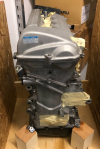Santa Barbarian
True Classic
After considerable delay, and with several False Starts, we're just getting ready to put a 2ZZ into an X-roller. And the question is: Is the native 2ZZ small enough that it can occupy a Bertone engine bay with no cuts to the firewall, trunk-- or relocation of tank and spare??
This began over in a discussion about another car with a K-swap in it, so this is a placeholder for what I hope turns into a serious build.
The subject engine is pictured below. Svelte, slender, light-weight, buff and powerful. How much baggage does he need to bring along?
This began over in a discussion about another car with a K-swap in it, so this is a placeholder for what I hope turns into a serious build.
The subject engine is pictured below. Svelte, slender, light-weight, buff and powerful. How much baggage does he need to bring along?

